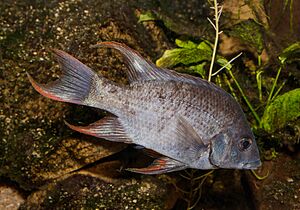Mangarahara cichlid facts for kids
Quick facts for kids Mangarahara cichlid |
|
|---|---|
 |
|
| Conservation status | |
| Scientific classification |
The Mangarahara cichlid (Ptychochromis insolitus), also known as joba mena, is a special type of cichlid fish. It is found only in certain rivers in northern Madagascar. This fish was once thought to be almost completely gone from the wild. It faced big threats like losing its home and competition from other fish.
After the last known female in a zoo died, people around the world became very worried. London Zoo started a big search to find any other Mangarahara cichlids. Luckily, a small group of these fish was found in 2013 by a fish farmer named Guy Tam Hyock. Now, thanks to breeding programs in Madagascar and at Toronto Zoo, thousands of baby Mangarahara cichlids have hatched.
What is the Mangarahara Cichlid?
Scientists first officially described the Mangarahara cichlid as a new species in 2006. They found it in the Amboaboa and Mangarahara Rivers near Mandritsara in northern Madagascar. Before its official name, people sometimes called it Ptychochromis sp. nov. "Joba mena." "Joba mena" means "red girl" in the local language. This name comes from the long, red-edged fins of the male fish.
This cichlid can grow up to about 10 inches (25.8 cm) long. Its scientific name, insolitus, is a Latin word meaning 'unusual' or 'strange'. This name was chosen because of its unique look. It has special comb-like structures called cteni on many of its scales. Scientists also noticed that some fish raised in captivity looked different from wild ones. This made them wonder if there might be another similar species.
Why is the Mangarahara Cichlid Endangered?
The Mangarahara cichlid was first listed as Critically Endangered in 2006. This means it was at a very high risk of becoming extinct. Later, after more research, scientists believed it was Extinct in the Wild. This means it no longer existed in its natural home. The IUCN (International Union for Conservation of Nature) listed it this way.
Before its rediscovery in 2013, people feared the last wild fish had vanished. This happened because their habitat (their natural home) was being destroyed. Also, new types of fish brought into the area were competing with them. Two other types of cichlids, Paretroplus nourissati and P. gymnopreopercularis, live in the same area. They might also be facing similar dangers.
Even though breeding programs have had some success, the fish's natural home is still in danger. This makes it hard to know if they can be put back into the wild safely.
Saving the Mangarahara Cichlid
In the 1990s, a French fish expert collected some Mangarahara cichlids from the wild. A couple who loved fish bred these specimens. In 2002, they gave a dozen young Mangarahara cichlids to London Zoo. At that time, no one knew how bad the situation was in the fish's natural home. Brian Zimmerman, a curator at the Zoological Society of London, thought other zoos had these fish too.
However, the young cichlids in the zoo fought with each other as they grew. This led to several fish dying. By 2005, London Zoo had only two male Mangarahara cichlids left.
In 2006, London Zoo heard bad news from Madagascar. The Mangarahara River had dried up. This happened because of a dam being built and water being taken for rice farms. The fish was then declared extinct in the wild.
In 2012, Aquarium Berlin tried to breed its male cichlid with its female cichlid. They were the only zoo with a female. But about ten days after putting them together, the male fish killed the female.
By 2013, only three male Mangarahara cichlids were known to exist in zoos. Two were at London Zoo and one at Aquarium Berlin. The ones in London Zoo were at least eleven years old. No one knew how long these fish usually lived.
In May 2013, London Zoo made a public plea. They asked for any information about female Mangarahara cichlids in private collections. They got tips from places like Venezuela, China, and Canada. But none of these led to finding any living cichlids.
Then, Guy Tam Hyock, a hotel owner and fish farmer, contacted Zimmerman. He offered to show London Zoo staff a small pond near Marotandrano. He believed a group of the fish still lived there.
In late 2013, Toronto Zoo and London Zoo confirmed that a small group of Mangarahara cichlids still lived in the wild. They were found at the spot Guy Tam Hyock mentioned. The last 18 wild fish, including some females, were caught. They were moved to Guy Tam Hyock's special fish farm in Andapa, Madagascar.
Soon after, these fish successfully bred at the farm. In September 2014, some of these fish were brought to Toronto Zoo. On September 15, 2016, Toronto Zoo announced that their cichlids had also successfully bred. They had at least 20 baby fish!


